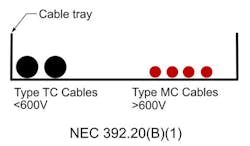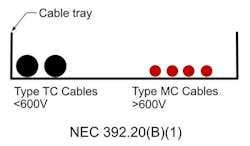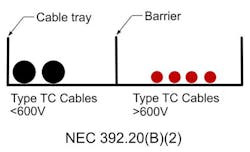Mixing Cables Over and Under 600V in Cable Tray
At times it becomes necessary, or even desirable, to route medium- or high-voltage cables (greater than 600V) in the same cable tray with cables rated 600V or less. Section 300.3(C)(2) of the National Electrical Code (NEC) has general requirements pertaining to the mixing of medium- and high-voltage cables with lower voltage cables in close proximity to one another. However, the general rule in Sec. 300.3(C)(2) is exclusive of cable trays.
To find the rule for mixing different voltage cables in cable trays, one must look to Sec. 392.20(B). In this section of the Code, we find that either rule (1) or (2) must be complied with.
The first condition states that when cables operating greater than 600V are mixed in the same tray with those 600V or less, the medium- or high-voltage cables (i.e., greater than 600V) must be Type MC. It’s important to remember that this rule doesn’t apply vice versa. In other words, it wouldn’t be acceptable to have 600V or less Type MC cables mixed in with nonmetal clad medium- and high-voltage cables, without some type of barrier installed in the tray to separate them.
The second condition allows you to install fixed solid barriers made of a material compatible with the cable tray material between the cables of differing voltage levels (i.e., those 600V and less and those greater than 600V). When installing a barrier in cable tray, in essence you’ve created separate cable trays. Therefore, no special requirements for cable types apply in this instance.
© 2016 Fluor Corporation. All Rights Reserved.
About the Author
Eddie Guidry
Senior Fellow
Eddie Guidry is a senior fellow with Fluor Enterprises, Inc., Sugar Land, Texas. He is highly skilled in electrical and control systems for industrial construction, design, and engineering (both domestic and abroad). The majority of Eddie’s 38 years of experience includes upstream and downstream portions of petrochemical plants and refineries. He is also heavily experienced in water and wastewater treatment facilities. Eddie is very active in the development of U.S. national (ANSI) and international codes and standards, and has been a principal member of the National Fire Protection Association (NFPA) National Electrical Code (NEC) committee since 1999 and NFPA’s National Advisory Committee on Electrical Safety Research since 2008. Eddie, who has also developed and conducted many electrical courses and seminars over the years, currently holds the corporate Master Electrician license for Fluor Corporation in the State of Texas and is also an ICC/IAEI certified electrical inspector.


